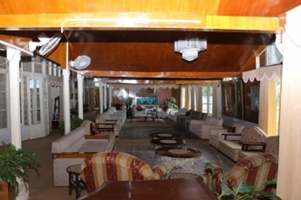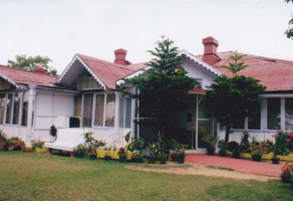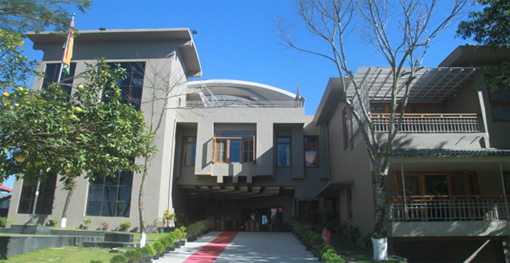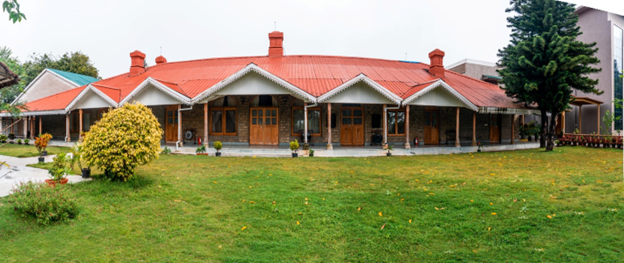The Mizoram Lok Bhavan Campus is situated in the heart of Aizawl town. The Campus is surrounded by the Government Secretariat and Mizoram Legislative Assembly buildings on the northern side; Republic Veng – a civilian residential area on the eastern side, and a small Children’s Park maintained by the Forest Department on the western side.
The main building of Raj Bhavan has undergone considerable structural changes since 1899, when it was first built. It housed the office as well as the official residence of the Governor. Apart from the personal apartments, the main building has one sitting room, lobby, dining hall and kitchen. The official residence of the Governor, which has now been shifted to first floor of the New Raj Bhawan Phase-I building, includes the Personal Apartment intended for his personal use and also the members of his family and guests. The original building will now consist of a Durbar Hall, office rooms of the Governor’s Secretariat, Household Establishment. The residences of the officers and staff of the Governor’s Secretariat and Household Establishment are also situated within the Lok Bhawan Complex. The old guest block called Annexe (now New Raj Bhawan Phase-I Building)is situated on the southern side of the main building and has six furnished rooms. With the Governor’s permission, guests, VVIPs and State guests visiting Mizoram from time to time are accommodated in the Guest Block.
The office of the Governor is located in the northern side of the main building and adjacent to this are the Durbar Hall, and the office of the Secretary and personal staff of the Governor. The old Durbar Hall was dismantled, constructed again by the State PWD and the New Durbar Hall was inaugurated in December, 1997. The Governor’s Secretariat building is situated at a slightly lower level towards the western side of Secretary’s office. The security guards guarding Raj Bhavan Complex also stay within the complex. Their barracks are towards the southern side of the Guest Block. The residential quarters of officers and other staff members of Raj Bhavan are on the southern side. Some staff quarters are located outside the Raj Bhavan Complex. They are on the southern side but at a walking distance.
The present Lok Bhavan complex covers an area of about 22,072 sq mts. Out of the total area, the buildings occupy an area of about 5000sq. mts. There is one big circular lawn surrounded by hedge and flower beds of roses and seasonal flowers. All the main functions and parties are held in this lawn. Around the lawn and offices are some very old trees which give the Raj Bhavan premises a majestic look. There is one Orchidarium, a network of other gardens and one rose garden. Also, one GNAT Air Craft used in the 1971 Indo-Pak War is kept within the campus. The Lok Bhavan complex has two main gates – Gate No. 1 is at the south-western side (which is now only used for VIP entrance) and Gate No 2 is on the northern side. On entering Gate No 1, there are two historic cannons installed in 1979.
After Independence, when in 1954 by an Act of Parliament the name ‘Lushai Hills District’ was replaced by ‘Mizo Hills District’ and when ‘Assam Lushai Hills Disctrict (Acquisition of Chief’s Rights) Act’ (1954) came into force, the post of Superintendent was abolished and the Deputy Commissioner was appointed. The Superintendent’s Bungalow then became the official residence of the Deputy Commissioner. In January 1972, when the Union Territory of Mizoram was formed, the building with some modifications, alterations and additions was converted into the official residence of the Lt Governor and was named ‘Raj Niwas’. In 1987, when Mizoram became a full-fledged state, the ‘Raj Niwas’ was renamed ‘Raj Bhavan’ and became the official residence of the Governor.
New Lok Bhavan Phase- I Inaugurated
A new Lok Bhavan Phase-I built next to the existing heritage building was inaugurated on 24th November 2016 by the Hon’ble Governor Lt Gen Nirbhay Sharma, PVSM, UYSM, AVSM, VSM, (Retd) in the august presence of Hon’ble Chief Minister Lal Thanhawla and other state dignitaries. Renovation work on the heritage building has also been completed. The walls of the original Bungalow built by Major J Shakespear which is considered a heritage portion of the building have been incorporated into the new structure as suggested by the INTACH Chapter of Mizoram.







